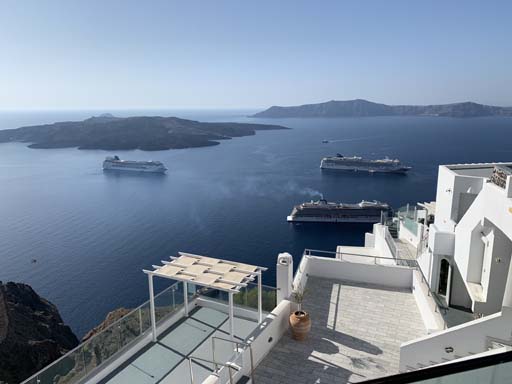Callisto has made a crabwise sideslip in order to avoid the 30+knot windstorm that’s about to crash into the Cyclades, and now we’re moored in Nauplion harbor in the Peloponnese. Any land excursions will occur safely on the mainland. So the only actual Cycladic island we visited was Santorini, as seen above. Spectacular but very much a victim of its own success, with no less than four cruise ships in the caldera (and this was a slow day. Normally it’s like eight).
I’m continually amazed how John and the crew has been replotting the whole journey, dealing with docking, supplies, land transport, permissions, etc.
Today we left the Bronze Age behind for the late Middle Ages. Monemvasia, known as “The Gibraltar of the East,” is a tall rock planted in the ocean and topped with spectacular Byzantine fortifications. The original inhabitants were Spartan refugees. The Byzantine town below the castle is guarded by the city walls, and had fallen into ruin until recent decades, when brave urban gentrifiers rebuilt much of it, and filled it with shops, hotels, and homes (though most live on the mainland and commute to work via a causeway).
Monemvasia was a profitable piece of Byzantium until it fell to a Frankish crusader, William of Villehardouin. When he was captured in battle with the Byzantines, he agreed to surrender three of his fortresses, including Monemvasia. After the fall of Constantinople, the Venetians took over, then the Ottomans, then the Venetians again. When menaced by the Ottomans a second time, the city appealed to the Pope, who offered to help if the locals met his conditions (which probably included giving up their religion). The Ottoman conditions were less onerous, and the city surrendered to the Turks.
From the 1970s on, Monemvasia has been besieged by tourists, to whom it has happily surrendered.
Next up was Mystras, another enormous Byzantine walled city spilling down the side of a mountain. The original castle atop the peak was built by good ol’ William of Villehardouin, who surrendered it to the Byzantines as part of his ransom. The place is freaking enormous, with very impressive fortifications, and it takes 90 minutes to walk from the top of the town down to the bottom (excluding the castle at the very top).
Mystras was the headquarters of the Despot, Constantine Palaiologos, who was called to the Byzantine throne just in time to be killed during the final siege of Constantinople. During the Greek War of Independence the entire population was killed by the Ottomans’ Egyptian allies, which kind of put an end to the place. People continued to squat there until the 1950s, chiefly because it offered safety, but it’s now a World Heritage Site and offers safety to nobody.
We’ll be back in the Bronze Age tomorrow, with a visit to an island that will take us back in time.
It’s an open question whether the boat’s wifi is powerful enough to upload this, so we’ll see how things stand.

This sounds like a fantastic adventure, with the elements of uncertainty brought on by the weather adding to the fun. Hope you continue to have a splendid time!
Comments on this entry are closed.